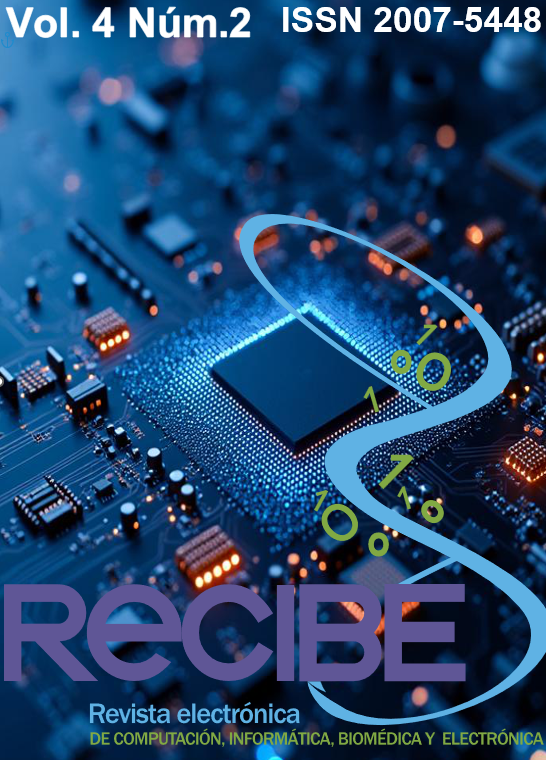Búsqueda de patrones basada en trayectorias extraídas de la respuesta de sistemas de segundo orden
DOI:
https://doi.org/10.32870/recibe.v14i2.318Palabras clave:
Metodos Metaheuristicos, Patrones de Busqueda, Sistemas de Segundo Orden, Metodos EvolutivosResumen
Recientemente, en la literatura se han introducido varios esquemas metaheurísticos nuevos. Aunque todos estos enfoques consideran fenómenos muy diferentes como metáforas, los patrones de búsqueda utilizados para explorar el espacio de búsqueda son muy similares. Por otro lado, los sistemas de segundo orden son modelos que presentan diferentes comportamientos temporales según el valor de sus parámetros. Tales comportamientos temporales pueden concebirse como patrones de búsqueda con múltiples comportamientos y configuraciones simples. En este artículo, se presentan un conjunto de nuevos patrones de búsqueda para explorar eficientemente el espacio de búsqueda. Estos emulan la respuesta de un sistema de segundo orden. El conjunto propuesto de patrones de búsqueda se ha integrado como una estrategia completa de búsqueda, llamada Algoritmo de Segundo Orden (SOA), para obtener la solución global de problemas de optimización complejos. Para analizar el rendimiento del esquema propuesto, se ha comparado en un conjunto de problemas representativos de optimización, que incluyen formulaciones de referencia multimodales, unimodales e híbridas. Los resultados numéricos demuestran que el método SOA propuesto exhibe un rendimiento notable en términos de precisión y altas tasas de convergencia.Citas
Askarzadeh, A. (2016). A novel metaheuristic method for solving constrained engineering optimization problems: Crow search algorithm. Computers & Structures, 169, 1–12. https://doi.org/10.1016/j.compstruc.2016.03.001
Beyer, H.-G., & Schwefel, H.-P. (2002). Evolution strategies – A comprehensive introduction. Natural Computing, 1(1), 3–52. https://doi.org/10.1023/A:1015059928466
Birbil, Ş. İ., & Fang, S.-C. (2003). An Electromagnetism-like Mechanism for Global Optimization. Journal of Global Optimization, 25(3), 263–282. https://doi.org/10.1023/A:1022452626305
Boussaïd, I., Lepagnot, J., & Siarry, P. (2013). A survey on optimization metaheuristics. Information Sciences, 237, 82–117. https://doi.org/10.1016/j.ins.2013.02.041
Cuevas, E., Echavarría, A., & Ramírez-Ortegón, M. A. (2014). An optimization algorithm inspired by the States of Matter that improves the balance between exploration and exploitation. Applied Intelligence, 40(2), 256–272. https://doi.org/10.1007/s10489-013-0458-0
Cuevas, E., Gálvez, J., Avila, K., Toski, M., & Rafe, V. (2020). A new metaheuristic approach based on agent systems principles. Journal of Computational Science, 47, 101244. https://doi.org/10.1016/j.jocs.2020.101244
Erol, O. K., & Eksin, I. (2006). A new optimization method: Big Bang–Big Crunch. Advances in Engineering Software, 37(2), 106–111. https://doi.org/10.1016/j.advengsoft.2005.04.005
Eskandar, H., Sadollah, A., Bahreininejad, A., & Hamdi, M. (2012). Water cycle algorithm – A novel metaheuristic optimization method for solving constrained engineering optimization problems. Computers & Structures, 110–111, 151–166. https://doi.org/10.1016/j.compstruc.2012.07.010
Haidekker, M. A. (2020). Linear Feedback Controls: The Essentials. Elsevier.
Han, M., Liu, C., & Xing, J. (2014). An evolutionary membrane algorithm for global numerical optimization problems. Information Sciences, 276, 219–241. https://doi.org/10.1016/j.ins.2014.02.057
Hansen, N. (2023). The CMA Evolution Strategy: A Tutorial (arXiv:1604.00772). arXiv. https://doi.org/10.48550/arXiv.1604.00772
Karaboga, D., Gorkemli, B., Ozturk, C., & Karaboga, N. (2014). A comprehensive survey: Artificial bee colony (ABC) algorithm and applications. Artificial Intelligence Review, 42(1), 21–57. https://doi.org/10.1007/s10462-012-9328-0
Kennedy, J., & Eberhart, R. (1995). Particle swarm optimization. Proceedings of ICNN’95 - International Conference on Neural Networks, 4, 1942–1948 vol.4. https://doi.org/10.1109/ICNN.1995.488968
Kirkpatrick, S., Gelatt, C. D., & Vecchi, M. P. (1983). Optimization by Simulated Annealing. Science, 220(4598), 671–680. https://doi.org/10.1126/science.220.4598.671
Marini, F., & Walczak, B. (2015). Particle swarm optimization (PSO). A tutorial. Chemometrics and Intelligent Laboratory Systems, 149, 153–165. https://doi.org/10.1016/j.chemolab.2015.08.020
Meng, Z., & Pan, J.-S. (2016). Monkey King Evolution: A new memetic evolutionary algorithm and its application in vehicle fuel consumption optimization. Knowledge-Based Systems, 97, 144–157. https://doi.org/10.1016/j.knosys.2016.01.009
Mirjalili, S. (2015). Moth-flame optimization algorithm: A novel nature-inspired heuristic paradigm. Knowledge-Based Systems, 89, 228–249. https://doi.org/10.1016/j.knosys.2015.07.006
Mirjalili, S., Mirjalili, S. M., & Lewis, A. (2014). Grey Wolf Optimizer. Advances in Engineering Software, 69, 46–61. https://doi.org/10.1016/j.advengsoft.2013.12.007
Morales-Castañeda, B., Zaldívar, D., Cuevas, E., Fausto, F., & Rodríguez, A. (2020). A better balance in metaheuristic algorithms: Does it exist? Swarm and Evolutionary Computation, 54, 100671. https://doi.org/10.1016/j.swevo.2020.100671
Poli, R., Kennedy, J., & Blackwell, T. (2007). Particle swarm optimization. Swarm Intelligence, 1(1), 33–57. https://doi.org/10.1007/s11721-007-0002-0
Rashedi, E., Nezamabadi-pour, H., & Saryazdi, S. (2009). GSA: A Gravitational Search Algorithm. Information Sciences, 179(13), 2232–2248. https://doi.org/10.1016/j.ins.2009.03.004
Rutenbar, R. A. (1989). Simulated annealing algorithms: An overview. IEEE Circuits and Devices Magazine, 5(1), 19–26. https://doi.org/10.1109/101.17235
Siddique, N., & Adeli, H. (2016). Simulated Annealing, Its Variants and Engineering Applications. International Journal on Artificial Intelligence Tools, 25(06), 1630001. https://doi.org/10.1142/S0218213016300015
Storn, R., & Price, K. (1997). Differential Evolution – A Simple and Efficient Heuristic for global Optimization over Continuous Spaces. Journal of Global Optimization, 11(4), 341–359. https://doi.org/10.1023/A:1008202821328
T, B. (1991). A Survey of Evolution Strategies. Proc. of Fourth Internal. Conf. on Genetic Algorithms. https://cir.nii.ac.jp/crid/1573950398979648512
Tang, K. S., Man, K. F., Kwong, S., & He, Q. (1996). Genetic algorithms and their applications. IEEE Signal Processing Magazine, 13(6), 22–37. https://doi.org/10.1109/79.543973
Valdivia-Gonzalez, A., Zaldívar, D., Fausto, F., Camarena, O., Cuevas, E., & Perez-Cisneros, M. (2017). A States of Matter Search-Based Approach for Solving the Problem of Intelligent Power Allocation in Plug-in Hybrid Electric Vehicles. Energies, 10(1), Article 1. https://doi.org/10.3390/en10010092
Yang, X.-S. (2009). Firefly Algorithms for Multimodal Optimization. In O. Watanabe & T. Zeugmann (Eds.), Stochastic Algorithms: Foundations and Applications (pp. 169–178). Springer. https://doi.org/10.1007/978-3-642-04944-6_14
Yang, X.-S. (2010). A New Metaheuristic Bat-Inspired Algorithm. In J. R. González, D. A. Pelta, C. Cruz, G. Terrazas, & N. Krasnogor (Eds.), Nature Inspired Cooperative Strategies for Optimization (NICSO 2010) (pp. 65–74). Springer. https://doi.org/10.1007/978-3-642-12538-6_6
Yang, X.-S., & Deb, S. (2009). Cuckoo Search via Lévy flights. 2009 World Congress on Nature & Biologically Inspired Computing (NaBIC), 210–214. https://doi.org/10.1109/NABIC.2009.5393690
Zhang, J., & Sanderson, A. C. (2007). JADE: Self-adaptive differential evolution with fast and reliable convergence performance. 2007 IEEE Congress on Evolutionary Computation, 2251–2258. https://doi.org/10.1109/CEC.2007.4424751
Zill, D. G. (2012). A First Course in Differential Equations with Modeling Applications. Cengage Learning.


